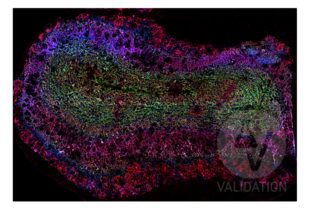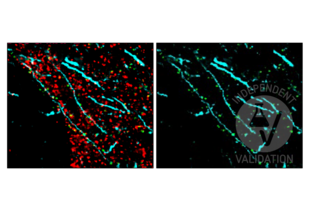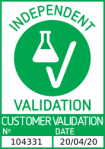DLG4 Antikörper
Kurzübersicht für DLG4 Antikörper (ABIN361694)
Target
Alle DLG4 Antikörper anzeigenReaktivität
Wirt
Klonalität
Konjugat
Applikation
Klon
-
-
Spezifität
- Detects ~100 kDa. An additional protein of >100 kDa is also detected. Additional cross-reactive bands are detected at ~75 kDa and 50 kDa in rat and mouse samples.
-
Kreuzreaktivität
- Rind (Kuh), Human, Maus, Ratte
-
Aufreinigung
- Protein G Purified
-
Immunogen
- Recombinant rat PSD-95
-
Isotyp
- IgG2a
-
-
-
-
Applikationshinweise
-
- WB (1:250)
- IHC (1:1000)
- ICC/IF (1:100)
- optimal dilutions for assays should be determined by the user.
-
Kommentare
-
1 μg/ml was sufficient for detection of PSD-95 on 20 μg rat brain tissue extract by ECL immunoblot analysis using Goat Anti-Mouse IgG: HRP as the secondary.
-
Beschränkungen
- Nur für Forschungszwecke einsetzbar
-
-
- by
- Akoya Biosciences
- No.
- #104331
- Datum
- 20.04.2021
- Antigen
- DLG4
- Chargennummer
- MP686150
- Validierte Anwendung
- Multiplex Immunohistochemistry
- Positivkontrolle
Fresh frozen mouse olfactory bulb
- Negativkontrolle
Unlabeled control (mouse fresh frozen)
- Bewertung
Passed. The anti-DLG4 antibody ABIN361694 specifically labels areas that contain high levels of post-synaptic boutons; these are located throughout the murine olfactory bulb and are concentrated in the glomerular layer.
- Primärantikörper
- ABIN361694
- Sekundärantikörper
- Full Protocol
- Protocol details are described in the Akoya Biosciences CODEX® User Manual (see https://www.akoyabio.com/wp-content/uploads/2021/01/CODEX-User-Manual.pdf).
- Tissue preparation as outlined in the Akoya Biosciences CODEX® User Manual fresh-frozen tissue protocol.
- Conjugation of the anti-DLG4 antibody ABIN361694 to an oligo barcode used to bind oligo-conjugated fluorophore ATTO 550.
- Anmerkungen
No signal was detected in unlabeled specimens.
Specific staining of DLG4 was also observed with human FFPE cortical tissue sections with both citrate antigen retrieval and EDTA antigen retrieval.
Optimal staining and signal to noise ratios were obtained if tissue was pre-treated for enogenous tissue autofluorescence removal (see https://www.akoyabio.com/wp-content/uploads/2020/07/Customer-Demonstrated-Protocol-Autofluorescence-Quenching-Mar2020.pdf).
Validierung #104331 (Multiplex Immunohistochemistry)![Erfolgreich validiert 'Independent Validation' Siegel]()
![Erfolgreich validiert 'Independent Validation' Siegel]() Validierungsbilder
Validierungsbilder![Murine fresh frozen coronal olfactory bulb section (Thickness = 5 µm) labeled with anti-DLG4 antibody ABIN361694 (red; bound to fluorophore ATTO 550). Labeling is present throughout olfactory bulb layers with a strong degree of labeling in the glomerular layer; this is consistent with the large number of postsynaptic targets within the glomerular neuropil. Slc17a7 and Map2 were labeled with ABIN1027710 (green; bound to fluorophore ATTO 550) and ABIN125739 (blue; bound to fluorophore ATTO 550).]() Murine fresh frozen coronal olfactory bulb section (Thickness = 5 µm) labeled with anti-DLG4 antibody ABIN361694 (red; bound to fluorophore ATTO 550). Labeling is present throughout olfactory bulb layers with a strong degree of labeling in the glomerular layer; this is consistent with the large number of postsynaptic targets within the glomerular neuropil. Slc17a7 and Map2 were labeled with ABIN1027710 (green; bound to fluorophore ATTO 550) and ABIN125739 (blue; bound to fluorophore ATTO 550).
Murine fresh frozen coronal olfactory bulb section (Thickness = 5 µm) labeled with anti-DLG4 antibody ABIN361694 (red; bound to fluorophore ATTO 550). Labeling is present throughout olfactory bulb layers with a strong degree of labeling in the glomerular layer; this is consistent with the large number of postsynaptic targets within the glomerular neuropil. Slc17a7 and Map2 were labeled with ABIN1027710 (green; bound to fluorophore ATTO 550) and ABIN125739 (blue; bound to fluorophore ATTO 550).
![FFPE normal human cortex tissue section labeled with anti-DLG4 antibody ABIN361694 (green; bound to fluorophore ATTO 550) after EDTA antigen retrieval. MAP2 and Synapsin were labeled with anti-MAP2 antibody ABIN125739 (cyan; bound to fluorophore ATTO 550) and anti-SYN1 antibody ABIN5542390 (red; bound to fluorophore AF488).]() FFPE normal human cortex tissue section labeled with anti-DLG4 antibody ABIN361694 (green; bound to fluorophore ATTO 550) after EDTA antigen retrieval. MAP2 and Synapsin were labeled with anti-MAP2 antibody ABIN125739 (cyan; bound to fluorophore ATTO 550) and anti-SYN1 antibody ABIN5542390 (red; bound to fluorophore AF488).
Protokoll
FFPE normal human cortex tissue section labeled with anti-DLG4 antibody ABIN361694 (green; bound to fluorophore ATTO 550) after EDTA antigen retrieval. MAP2 and Synapsin were labeled with anti-MAP2 antibody ABIN125739 (cyan; bound to fluorophore ATTO 550) and anti-SYN1 antibody ABIN5542390 (red; bound to fluorophore AF488).
Protokoll -
-
Format
- Liquid
-
Konzentration
- 1 mg/mL
-
Buffer
- PBS pH 7.4, 50 % glycerol, 0.09 % sodium azide, Storage buffer may change when conjugated
-
Konservierungsmittel
- Sodium azide
-
Vorsichtsmaßnahmen
- This product contains Sodium azide: a POISONOUS AND HAZARDOUS SUBSTANCE which should be handled by trained staff only.
-
Lagerung
- -20 °C
-
Informationen zur Lagerung
- -20°C
-
-
- DLG4 (Discs, Large Homolog 4 (Drosophila) (DLG4))
-
Andere Bezeichnung
- PSD95
-
Hintergrund
- Postsynaptic Density protein 95 (PSD95), also known as Synapse associated protein 90 kDa, is a member of the membrane-associated guanylate kinase (MAGUK) family of proteins. PSD95 is a scaffolding protein and is involved in the assembly and function of the postsynaptic density complex (1). These family members consist of an N-terminal variable segment followed by three amino-terminal PDZ domains, an upstream SH3 domain and an inactive carboxyl-terminal guanylate kinase (GK) domain. The first and second PDZ domain localize NMDA receptors and K+ channels to synapses, and the third binds to neuroligins which are neuronal cell adhesion molecules that interact with b-neurexins and form intercellular junctions. PSD-95 also binds to neuronal nitric oxide synthase, possibly through interactions between PDZ domains present on both proteins (2). Thus different PDZ domains of PSD-95 might be specialized for distinct functions (3, 4). PSD95 participates in synaptic targeting of AMPA receptors through an indirect manner involving Stargazin and related transmembrane AMPA receptor regulatory proteins (TARPs) (5). The protein is implicated in experience dependent plasticity and plays an indispensable role in learning (6). Mutations in PSD95 are associated with autism (7).
-
Gen-ID
- 29495
-
NCBI Accession
- NP_062567
-
UniProt
- P31016
-
Pathways
- Regulation of Muscle Cell Differentiation, Synaptic Membrane, Skeletal Muscle Fiber Development, Asymmetric Protein Localization, Regulation of long-term Neuronal Synaptic Plasticity
Target
-



 (1 Validierung)
(1 Validierung)



